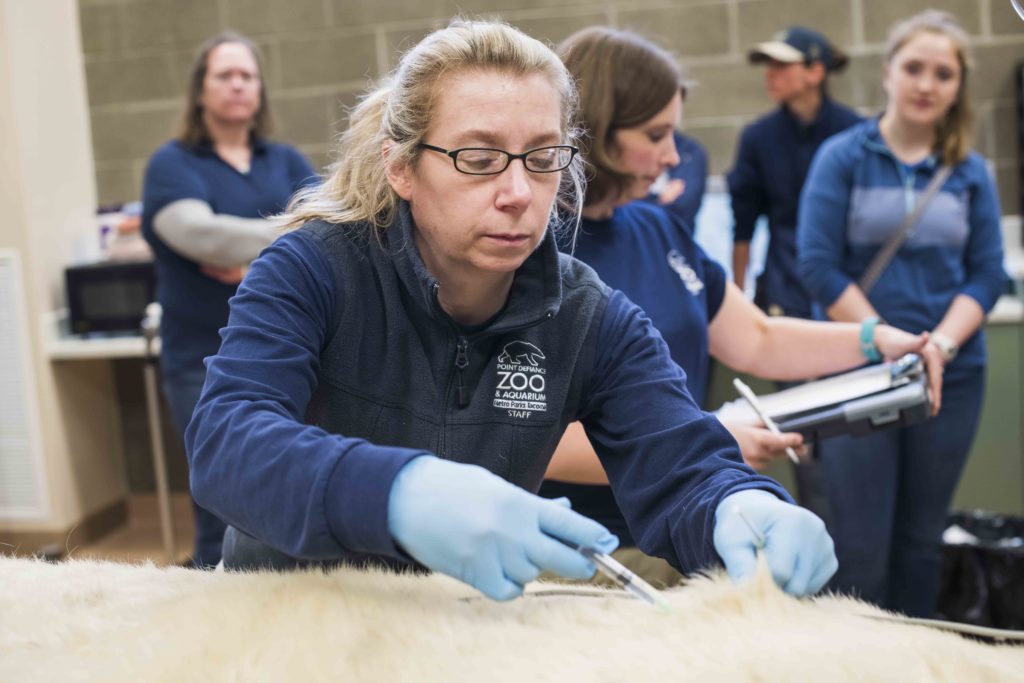For Veterinary Technician Week 2019, we’re not just celebrating our wonderful vet techs – we’re introducing them to you! Vet techs assist veterinarians in every aspect of animal health care, and they care deeply about our animals – often in very practical ways. We couldn’t care for animals without them.
Meet Julie Lemon, full-time vet tech at Point Defiance Zoo & Aquarium.
(Meet our other vet tech Sara Dunleavy here.)
How many years have you worked at PDZA?
I graduated in 1997 from the veterinary technician program at the State University of New York, Delhi. After interning at Cincinnati Zoo and Indianapolis Zoo I worked at Lincoln Park Zoo, and began at Point Defiance in 2001. So – 18 years here!

Why did you decide to be a vet tech?
I’ve always loved animals: horses, cats and tigers, all kinds. For a long time I thought I would become a nurse for human patients, but then I had a Golden Retriever who had all the usual problems for his breed: skin issues, seizures. I was always taking him to the vet. I started volunteering there, and then I realized I could be an animal nurse! And from the start I always knew I wanted to work with exotic, not domestic animals.
Tell us what you do – what does an average day look like?
There is no average day! I arrive at 7:30am, and start with treatments of all the hospital patients: medications, checkups, weighing, changing out their enclosure. There’s always something happening with the budgies! Then the health care team meets to do rounds and discuss the day’s responsibilities. We have two full-time veterinarians, one vet intern, myself and a part-time vet tech, and the hospital registrar. Most mornings there’s at least one procedure: for those I set up equipment and testing, or pack it all up if we are working with the animal in its own space. I assist with anesthesia, monitor heart rate, temperature and respiration, collect blood and do radiographs, give vaccines or fluids, assist with surgery and collect and prepare samples. Then afterwards I’ll clean up and get the hospital ready for the next patient.
During the rest of my day I’ll give medications, work with keepers on training for health care and maintain the hospital and supplies. One really interesting thing I do is noninvasive laser therapy for wound healing or other conditions. Currently I’m working with tapir, elephant, penguin, tortoise and goat patients.
Do you have a favorite animal?
I love all of them, they’re all amazing. But I kind of have favorites – Scooter the armadillo, and Pilai the hornbill. I love them so much, and they love me back: Pilai will regurgitate her grapes for me as a sign of affection.
Nice! What do you do with them?
I pretend to, and say “oh, how nice!” Then I secretly put them in the trash…
What’s your favorite part of this job?
The variety. I’m always learning, and medicine and science are always progressing. We practice excellent medicine here – I’m proud to be a part of such a fantastic veterinary team.
Any advice about this career?
You have to love animals, and be passionate about what you do.
And do you have pets at home?
I have a golden retriever and a rescued Great Pyrenees/border collie cross, who’s just 10 months old. And three horses, too.
Wow. Does this mean getting up really early?
Yes – my alarm goes off at 5:15am.